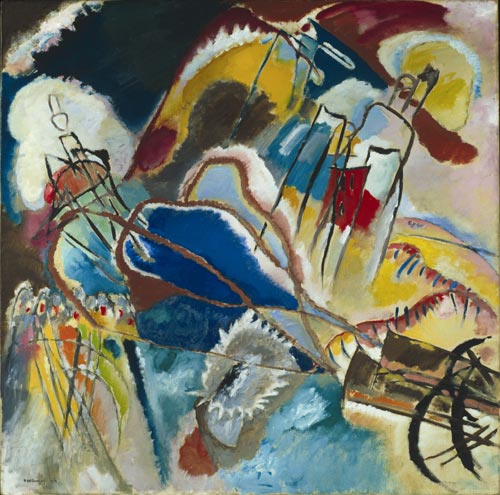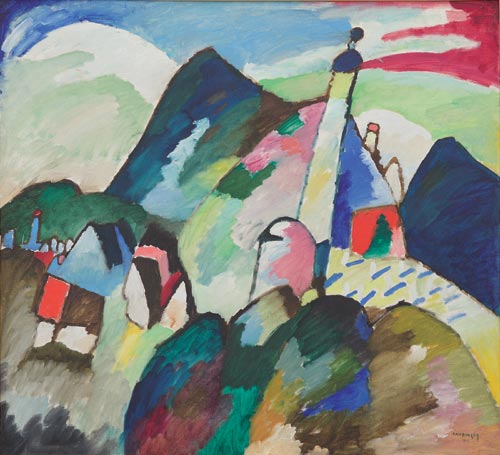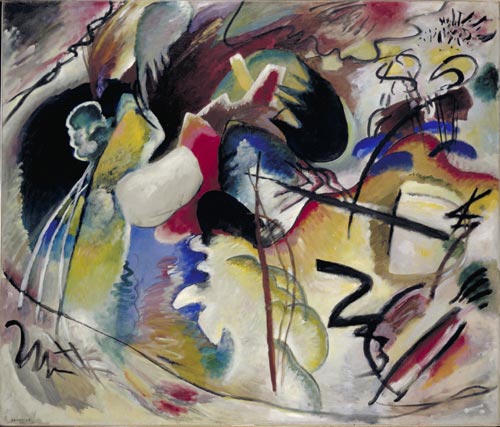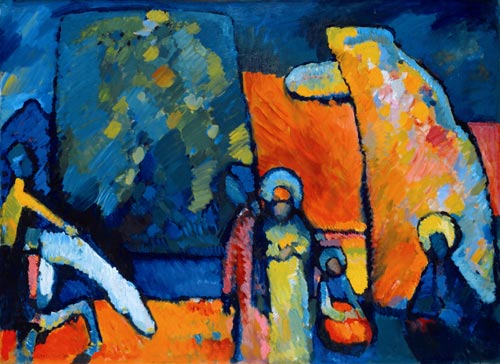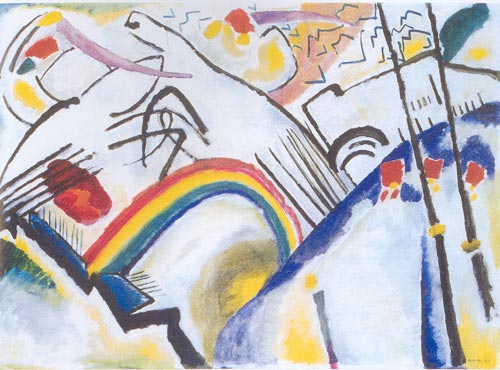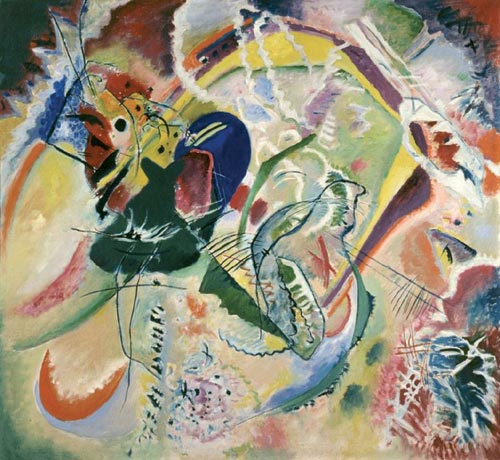

Tate Modern, London
22 June-1 October 2006
Kunstmuseum, Basel
21 October 2006-4 February 2007
Paul Overy’s study of Kandinsky remains the most satisfying. 'Kandinsky’s approach to abstraction was supported by constant thought and examination of the problems involved and his theoretical statements often anticipate the paintings. Certainly, he was by far and away the most important artist to experiment with abstraction around 1910 and the only one who developed a thoroughly coherent style.'1 Norbert Lynton shares Overy’s frustration with the preoccupation by scholars with abstraction at the expense of an adequate appraisal of Kandinsky’s work. Referring to the Tate exhibition this summer, and the accompanying catalogue and wall text, he states:
We read in two places that Kandinsky was 'a pioneer in the development of a new visual language - abstraction', but all art is 'abstraction', even a Constable landscape. No one tackles the question of what is meant by the term here. The path is pointed to, again and again, and the exhibits are produced in evidence of his progress along it, but its goal is left vague.2
Russian-born Wassily Kandinsky was a prolific and inspiring artist and intellectual, whose writings were a key to understanding abstraction as the expression of ‘inner necessity’ on the part of the artist, whose messianic vision would lead society to a better world. By limiting the study of Kandinsky to the emergence of abstraction, this reduces the value of his work, which is full of invention and originality. His extraordinary blend of apocalypse and neo-Platonic vision was the product of the tense period during the first two decades of the 20th century. The influence of the theosophical ideas of Madame Blavatsky and the anthroposophy of Rudolph Steiner on Kandinsky’s writings of the pre-1914 period have been overstated by certain historians, and latterly journalists, and used to undermine Kandinsky’s importance as a painter.
Kandinsky’s theoretical works have, during the last few years, become the hunting ground of art historians and scholars. (His paintings have been relatively neglected by critics and the view that Kandinsky was more important as a historical phenomenon and a theorist is still widely held.) These scholars have taken an especial delight in pointing out the 19th-century sources from which many of Kandinsky’s theoretical writings derive and seem never to have cast more than a second glance at the paintings which they help to illuminate.3
In spite of the glorious manifestation of colour in Kandinsky’s paintings, foreboding characterises many of his works:
The sense of impending disintegration and chaos that his paintings of this year communicate show that Kandinsky was fully aware of the imminent collapse of the pre-war 1914 world. It was not only an international but also a personal crisis. A lesser artist would probably not have survived this; his paintings after the war would have been hollow echoes of his earlier style. Perhaps because he was a mature man in his late 40s who had only taken up painting after an exacting intellectual academic training, Kandinsky was able to survive as an artist and to develop a style, an artistic language, which enabled him to come to terms with the post-war world. Kandinsky’s later, geometric works shocked many of his former admirers in Germany so deeply that they broke off relations with him. Even today many critics still prefer the Munich paintings. But his later work was, in fact, a perfectly coherent and necessary development, which enabled Kandinsky during the Bauhaus period at least to match the quality of his finest Munich works and during his final years in Paris to excel them in power and range.4
The relationship between art and music is central to an examination of Kandinsky’s work in the exhibition this summer at Tate Modern, with paintings entitled 'Composition' and 'Improvisation'. Kandinsky also wrote and published poetry in which he emphasised the sound of words, rather than their meaning. The works themselves are among the outstanding masterpieces of the 20th century. His life and work are those of a brilliant and prolific intellectual artist; as the exhibition testified, his works have a pivotal position and enduring quality that was recognised by artist contemporaries of Kandinsky, better perhaps than subsequent commentators and art historians. Diego Rivera, in 1931, on the occasion of an exhibition in San Francisco, stated:
I know of nothing more real than the painting of Kandinsky - nor anything more true and nothing more beautiful. A painting by Kandinsky gives no image of earthly life - it is life itself. If one painter deserves the name ‘creator’, it is he. He organises matter as matter was organised, otherwise the Universe would not exist. He opened a window to look inside the All. Someday, Kandinsky will be the best known and best loved of men.5
'Kandinsky: The Path to Abstraction' was claimed to be the first major exhibition in Britain to focus on the paintings of Wassily Kandinsky (1866-1944). It was met with a mix of praise and hostility, ridicule of theosophy and a simplified reliance on the theory of synthanaesia, the ability to see music.6 In 1999, however, the Royal Academy showed some 140 Kandinskys from every period - all small-scale works on paper and cardboard. The Tate exhibition represents a precise period in Kandinsky’s career, 1905-21, one that includes the necessary elements of his development without attempting to appraise the complex issues pertaining to Kandinsky’s vast oeuvre. The exhibition examines the most popular period in Kandinsky’s career spanning his time in Munich and Murnau in the second decade of the 20th century, his return to Moscow in 1914 and his departure there in 1922 for Weimar via Berlin, where he accepted a teaching post at the Bauhaus. In those 13 years, the spiritual, social and political circumstances of the world had been shattered. Kandinsky’s friends and fellow artists, Franz Marc and August Macke, were among the millions of young men slaughtered in the First World War.
The old boundaries and balances of power of pre-1914 Europe had been swept away. Germany had been defeated and humiliated. Russia had gone through the pain and hope of revolution and, already, disillusion was beginning to set in. The war caused a traumatic break in the intellectual and artistic life of Europe. Artists and writers had been in revolt against the sterile, complacent pre-1914 society with its obsolete values. And that society had been swept away in a more devastating and terrible way than they could ever have dreamed of.7
Wassily Kandinsky was born in Moscow in 1866, the son of a wealthy Siberian tea merchant and his wife, Lydia Ivanovna Tiheeva, from Moscow. In 1871, the family moved to Odessa, where Wassily stayed on with his mother after his parents divorce. He learnt cello and piano from a young age and attended a humanistic secondary school there. In 1885, Kandinsky moved back to Moscow where he attended the University of Moscow to study law and economics. After qualifying, he travelled to Vologda where he published two articles on peasant law and paganism among Siberian tribes. He painted and he discovered peasant folk art. Following the legal and ground roots experience in Russia, he made two important trips to Paris. In 1893, Kandinsky completed his PhD on the legality of labourer’s wages. He was also offered a position in the Faculty of Law, University of Moscow.
In 1895, Kandinsky saw the 'Haystack' series of paintings by Claude Monet, on show in Moscow. He also had what has been recognised as that of a synaesthetic experience while listening to Wagner. He later wrote: 'I saw all my colours in spirit, before my eyes. Wild, almost mad lines drew themselves in front of me'. Now financially independent, he moved to Munich in 1896 and enrolled in art classes. As a student there he met Alexei Jawlensky, Marianne von Werefkin and Paul Klee. By 1901, Kandinsky was also writing art reviews, particularly for Sergei Diaghilev’s Moscow progressive art journal Mir Iskusstva. Kandinsky’s paintings in gouache, temperas and small works in oil were mostly landscapes with legends and scenes from mediaeval Russian art. He had his first exhibition in Germany the same year, and travelled back to Russia. He met Gabriele Münter, with whom he lived for ten years, and was actively involved with artists, teaching and exhibitions. Greatly inspired again by his Russian heritage on a journey back to Moscow via Venice and Vienna, he wrote to Münter: 'I have a very strange sensation here in Moscow. Hundreds of memories, partly forgotten pictures, the whole character of the genuine Russian town which I feel and understand even today, these churches, carriages, flats people who are so distant yet so familiar. I have been away from her for seven years and only now, for the first time, I am having these sensations'. Kandinsky created and published a small book, a series of woodcuts, 'Poems without Words', inspired by Russian folk picture books. He also worked on embroidery, jewellery, clothes and furniture.
Central to his career as a theorist, Kandinsky began to investigate ‘form’ in art - form created from inner necessity. Kandinsky travelled extensively in Italy and to Paris with Gabriele Münter. He had his first solo exhibition in Munich in 1905, and painted, exhibited and wrote extensively. It was not until 1908 when Kandinsky was 42 that he began to produce major works. He also worked on his art theory, in particular, Concerning the Spiritual in Art, which was published in 1911.
Kandinsky and Franz Marc formed a group, Die Blaue Reiter (The Blue Rider), which, with Die Brücke (The Bridge) was the most important organisation of artists in pre-1914 Germany. Its first exhibition included artists from outside of Germany: Robert Delaunay and Douanier (Henri) Rousseau. The second exhibition included a formidable range of work by Arp, Braque, Derain, Goncharova, Heckel, Kirkner, Klee, Larionov, Malevich, Nolde, Pechstein, Picasso and Vlaminck. Kandinsky, Marc and Macke produced The Blaue Reiter Almanac, which included articles on music, theatre and art. Kandinsky wrote half of the articles and translated articles from Russian. The work included children’s art and folk art, for Kandinsky was interested in 'the organic interior roots of art in general', as much as the finished work. The interaction between art and the life of human society was essential, as was Kandinsky’s Russian Orthodox Christian faith. According to Paul Overy, Kandinsky’s faith is a fact rarely considered by critics of his work.8
In 'Reminiscences' Kandinsky draws many parallels between art and Christianity. He compares art to religion in that its development does not consist of new discoveries that controvert former theories (as in science) but of new truths, which grow organically from the old, but do not render the old truths obsolete.9
Kandinsky remained optimistic about the future even when war destroyed so much of society. He equated representational painting with traditionalism. When he published a revised version of his autobiographical essay in 1918 he cut out many references to Christianity, out of the necessary respect for the Communist regime, even though he was never a Communist himself. If they were published, today, they would no doubt be dismissed along with references to theosophy and Steiner and further spiritual views that have been unpopular in mainstream visual arts for most of the 20th century. The path to abstraction is undeniably vital to placing Kandinsky in a historical context and in the wider scheme of art history. In the process, one hopes that the essential meaning of Kandinsky’s work will be clarified and linked to issues in contemporary art practices. Although he had strong ideological links with individuals, groups and institutions, Kandinsky has to be viewed as a unique, and rare talent whose extraordinary faith in art, ideas, spirituality, Christian redemption produced paintings that are in Rivera’s words, 'life itself'. Kandinsky’s paintings convey life in its intensity and complexity. He expresses drama, destruction, complex relationships, candid beauty, courage and redemption through exquisite orchestrations of colour and line, like no other artist before or since.
Dr Janet McKenzie
References
1. Overy P. Kandinsky: The Language of the Eye. London: Elek, 1969: 13.
2. Lynton N. 'The infectious impurity of Kandinsky's "visual music": abstraction’s true colours'. Times Literary Supplement, 21 July 2006: 18.
3. Overy P. Kandinsky: The Language of the Eye. London: Elek, 1969: 31.
4. Ibid: 17.
5. Ibid: 11.
6. Ward O. 'The man who heard his paintbox hiss'. Telegraph, 10 June 2006.
7. Ibid: 15.
8. Ibid: 19.
9. Ibid: 29.
